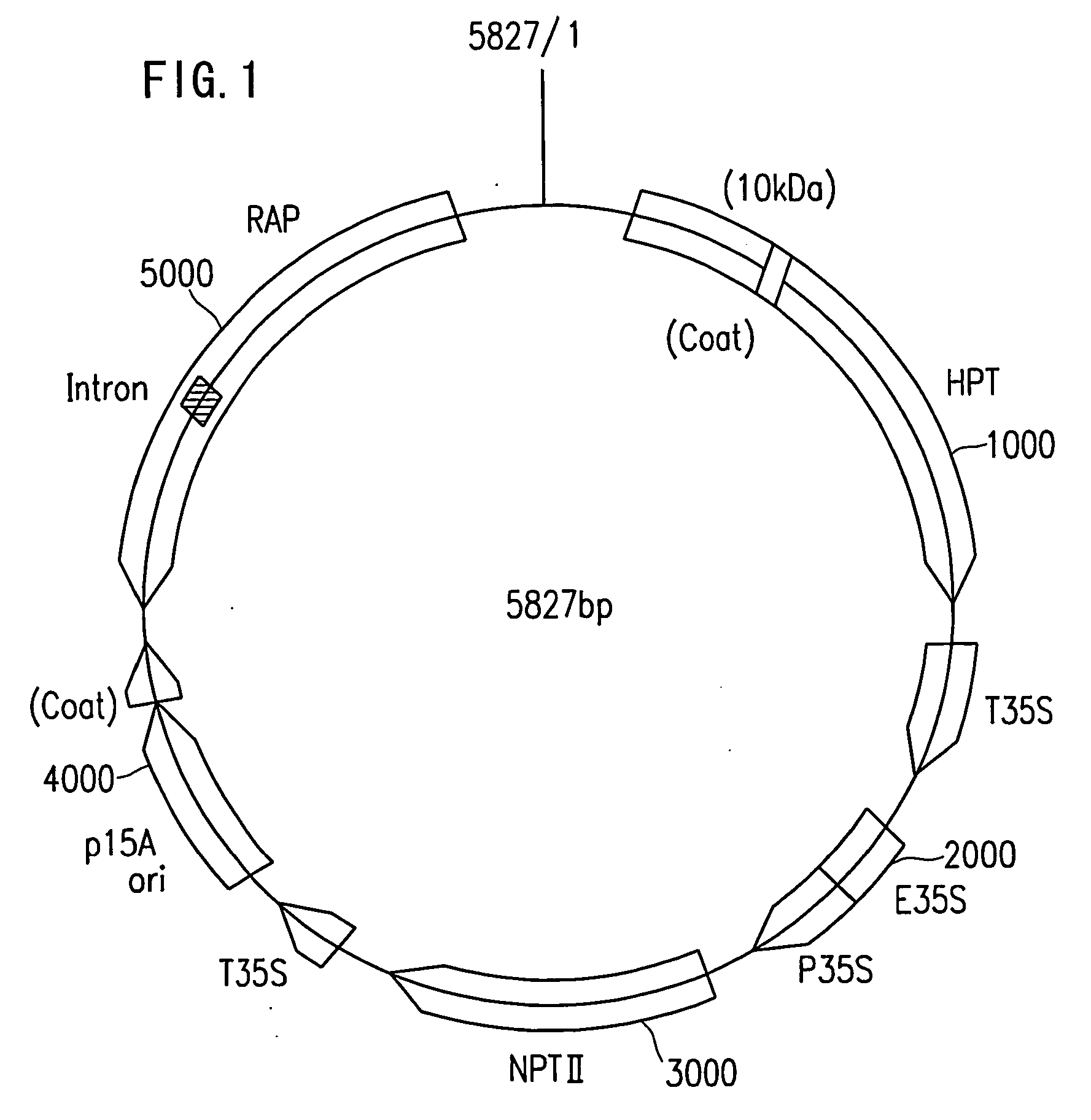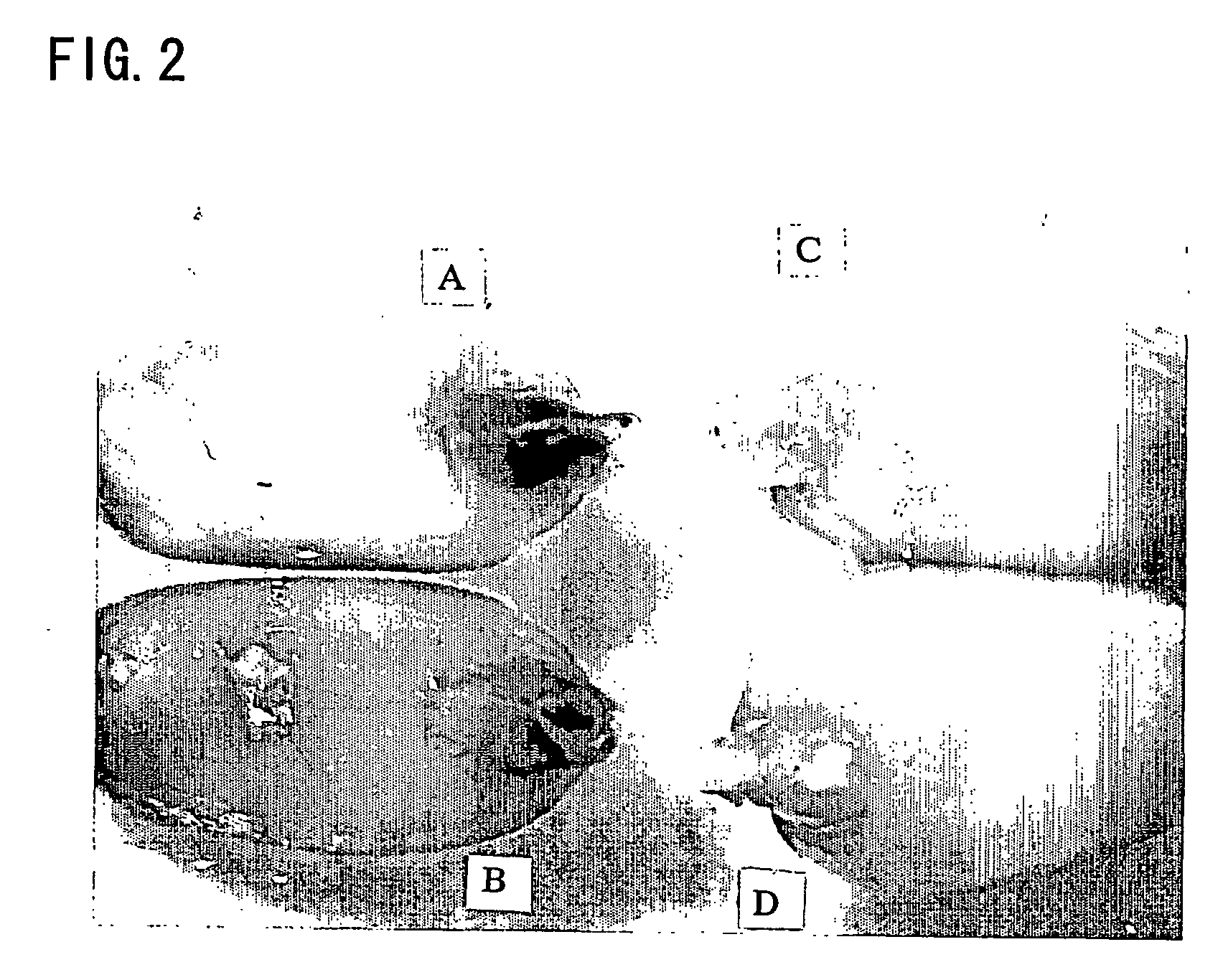Electroporation method including the use of depressurization/pressurization
a technology of electroporation and depressurization, which is applied in the direction of specific use bioreactors/fermenters, biomass after-treatment, biochemical apparatus and processes, etc., can solve the problems of low efficiency of regeneration of transformants (e.g., a transformed whole plant) from transformed tissue, and achieve the effect of achieving plant electroporation and significantly improving the efficiency of nucleic acid transfer
- Summary
- Abstract
- Description
- Claims
- Application Information
AI Technical Summary
Benefits of technology
Problems solved by technology
Method used
Image
Examples
example 1
[0188] (Transformation of Wheat)
[0189] Mature seeds of wheat (variety: Norin 61) were subjected to experiments. The seeds were allowed to absorb water at 25° C. overnight. 2 ml of an electroporation buffer solution containing 30 seeds which had begun sprouting and plasmid DNA (200 μg / 2 ml) of pWI-GUS (for GUS analysis) or pWI-H5K (for growth) were placed in a petri dish. Depressurization was performed at 0.096 MPa below an atmospheric pressure for 1 h. Thereafter, the seeds and the buffer solution were transferred from the petri dish to a chamber. The chamber was placed on ice for 1 min. Thereafter, an electric pulse was applied under the following conditions: the pulse width was 50 μsec and the number of pulses was 50. The chamber was further allowed to stand on ice for 2 min. Thereafter, the seeds and the buffer solution were placed back to the original petri dish. The petri dish was preserved at 4° C. for about 1 h, and thereafter, was allowed to stand at 25° C. overnight. On th...
example 2
[0200] Mature seeds of Japonica rice (variety: Koshihikari) were used as material.
[0201] The seeds were allowed to absorb water at 25° C. overnight. 2 ml of an electroporation buffer solution containing 30 seeds which had begun sprouting and plasmid DNA (200 μg / 2 ml) of pWI-GUS or pWI-H5K were placed in a petri dish. Depressurization was performed at 0.096 MPa below an atmospheric pressure for 1 h. Thereafter, the seeds and the buffer solution were transferred from the petri dish to a chamber. The chamber was placed on ice for 1 min. Thereafter, an electric pulse was applied under the following conditions: the voltage was 50 V where the distance between electrodes was 1 cm, the pulse width was 50 μsec, and the number of pulses was 99. The chamber was further allowed to stand on ice for 2 min. Thereafter, the seeds and the buffer solution were placed back to the original petri dish. The petri dish was preserved at 4° C. for about 1 h, and thereafter, was allowed to stand at 25° C. o...
example 3
[0211] Mature seeds of Indica rice (variety: IR24) were used as material.
[0212] The seeds were allowed to absorb water at 25° C. overnight. 2 ml of an electroporation buffer solution containing 30 seeds which had begun sprouting and plasmid DNA (200 μg / 2 ml) of pWI-GUS were placed in a petri dish. Depressurization was performed at 0.096 MPa below an atmospheric pressure for 1 h. Thereafter, the seeds and the buffer solution were transferred from the petri dish to a chamber. The chamber was placed on ice for 1 min. Thereafter, an electric pulse was applied under the following conditions: the voltage was 50 V where the distance between electrodes was 1 cm, the pulse width was 50 μsec, and the number of pulses was 99. The chamber was further allowed to stand on ice for 2 min. Thereafter, the seeds and the buffer solution were placed back to the original petri dish. The petri dish was preserved at 4° C. for about 1 h, and thereafter, was allowed to stand at 25° C. overnight. On the nex...
PUM
| Property | Measurement | Unit |
|---|---|---|
| atmospheric pressure | aaaaa | aaaaa |
| distance | aaaaa | aaaaa |
| distance | aaaaa | aaaaa |
Abstract
Description
Claims
Application Information
 Login to View More
Login to View More - R&D
- Intellectual Property
- Life Sciences
- Materials
- Tech Scout
- Unparalleled Data Quality
- Higher Quality Content
- 60% Fewer Hallucinations
Browse by: Latest US Patents, China's latest patents, Technical Efficacy Thesaurus, Application Domain, Technology Topic, Popular Technical Reports.
© 2025 PatSnap. All rights reserved.Legal|Privacy policy|Modern Slavery Act Transparency Statement|Sitemap|About US| Contact US: help@patsnap.com



